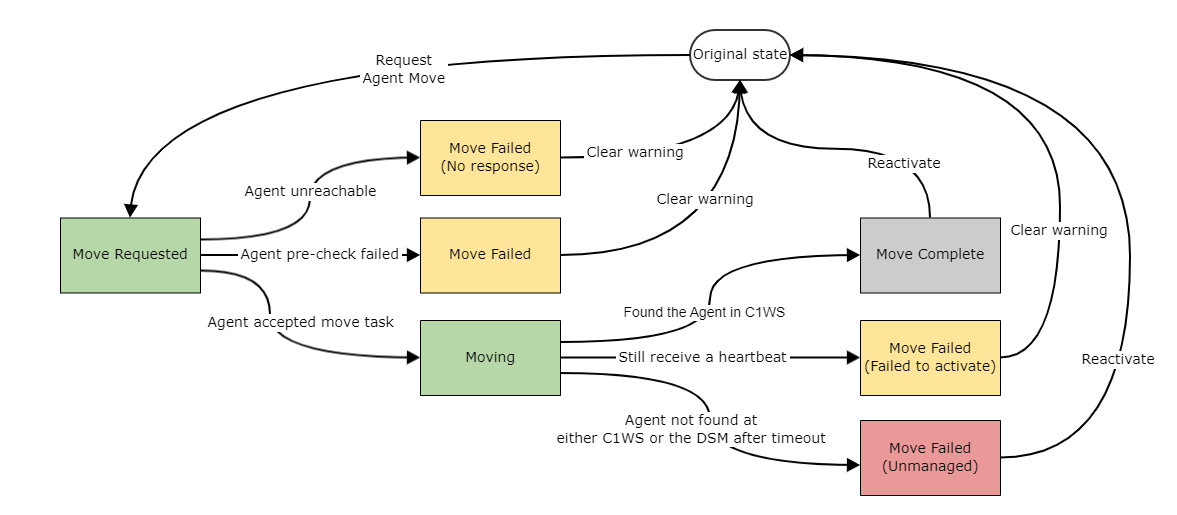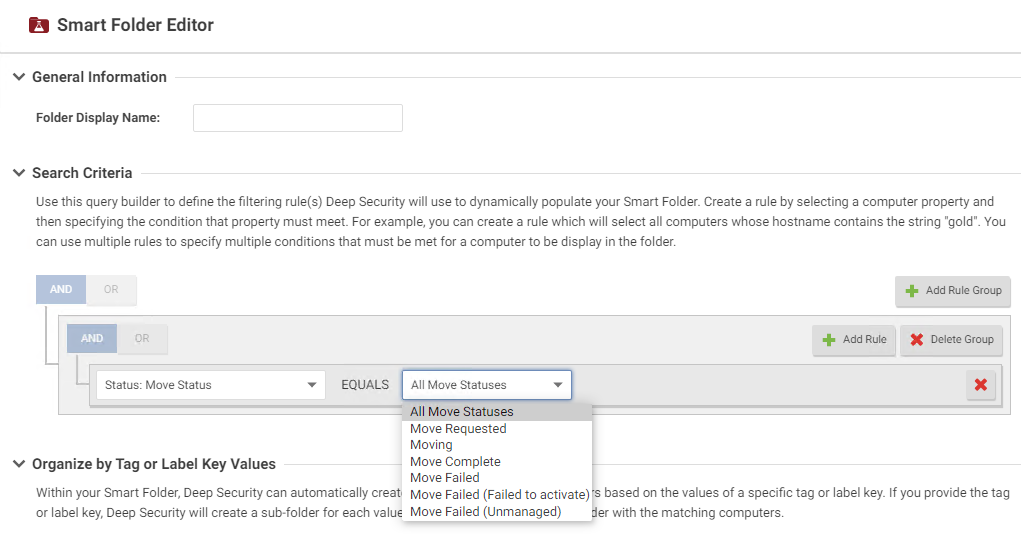Migrate agents to Trend Cloud One - Endpoint & Workload Security
Migrate to Trend Cloud One - Endpoint & Workload Security is a multi-step process.
Prerequisites
- Ensure that you are using Deep Security Manager 20.0.321 (20 LTS 2021-01-26) or later for migrating via APIs, or Deep Security Manager 20.0.513 (20 LTS Update 2021-10-14) or later for migrating using the Deep Security Manager migration tool.
- Ensure that you are using Deep Security Agent 20.0.0-3445 (20 LTS Update 2021-11-24) or later. Then, in the Workload Security console, go to Administration > Updates > Software > Local and make sure your account has the corresponding Deep Security Agent package.
- Ensure that your agents are running on platforms that support migration:
- The Agent platform support table lists agent platforms supported by Deep Security Manager 20.
- Migrating agents is validated only on Windows and Linux platforms on Intel architecture.
- Migrating agents is not supported on Windows 2008 32-bit.
- Due to feature differences between Deep Security Manager and Workload Security, disable the following before migrating agents:
- FIPS 140: Deep Security Manager will refuse to migrate if FIPS 140 is enabled.
- Virtual Appliance: Computers protected by Virtual Appliance (agent-less or combined-mode) will refuse to migrate.
- If you have not done so already, complete the earlier steps described in Migrate to Trend Cloud One - Endpoint & Workload Security, including creating a Trend Cloud One account, creating an API key, and preparing a link to Workload Security.
Migrate agents using the migration tool
The Migrate to Trend Vision One Endpoint Security tool used to be called Migrate to Workload Security. This tool enables migration for both Trend Vision One Endpoint Security - Server & Workload Protection and for Trend Cloud One - Endpoint & Workload Security. Note that in addition the tool itself, the related role configurations have been renamed.
- In the Deep Security Manager console, select Support > Migrate to Trend Vision One Endpoint Security.
- On the Migrate to Trend Vision One Endpoint Security page that appears, select the Agents tab.
- Select Migrate using Computers page. The Deep Security Computers page is displayed.
- Select one or more computers that you want to migrate.
- Select Actions > Migrate to Trend Vision One Endpoint Security.
- Specify the settings that you want applied to the agents when moved, and then click Migrate:
- Security Policy: If you have migrated your Deep Security policies to Workload Security and want to keep the same policy applied to the migrated agent, select Assign migrated policy. If you want to assign a different policy, choose Select a policy from Trend Vision One Endpoint Security and select the new policy.
- Computer Group: The computer group where the agents will be located in Workload Security.
- Relay Group: All agents will be assigned to the Primary Relay Group in Workload Security.
- Proxy to contact Server & Workload Protection Manager: Select a proxy if agents need one to contact Workload Security.
- Proxy to contact Relay(s): Select a proxy if agents need one to contact relays on Workload Security.
- Migrate with existing hostname, display name, and description: Select this to use the existing hostname, display name, and description for the migrated agent.
- Migrate with settings override at computer level: Select this to migrate any settings that have an override at the computer level. This does not include rule assignments.
- Check the move status.
- If you run into problems, check Troubleshooting
Check the move status
The status of move tasks is available from the API response, computers page, and system events. The move status is also a search criteria in smart folders.
The original state of a move task is that the agent is managed by an on-premises Deep Security Manager.

| Status | Description | How to recover to original state |
| Move Requested |
A move task to Workload Security has been requested. The move task has been accepted by Deep Security Manager, but not yet sent to the agent. |
N/A |
| Moving |
Computer is being moved to Workload Security. The agent has accepted the move task, and is moving to Workload Security. |
N/A |
| Move Complete |
Computer has been moved successfully to Workload Security. Deep Security Manager is able to identify that the moved agent is activated on Workload Security. |
Manually reactivate the agent back to Deep Security Manager. Note that the agent has already trusted the Workload Security public certificate. You must remove the ds_agent_dsm_public_ca.crt file manually before activating the agent back to Deep Security Manager. |
| Move Failed |
Computer was not moved to Workload Security due to a connectivity issue from the agent to Workload Security. The agent has rejected the move task while performing its precheck. Before trying the move again:
|
Clear Warnings on the console. The agent is still managed by Deep Security Manager. |
| Move Failed (No response) |
Computer was not moved to Workload Security because the agent did not respond to the move task in a timely manner. Before trying the move again:
|
Clear warnings on the console. The agent is still managed by Deep Security Manager. |
| Move Failed (Failed to activate) |
The move to Workload Security failed due to an activation issue and was rolled back. The pre-check passed, but the agent was unable to activate to Workload Security. Before trying the move again:
|
Clear warnings on the console. The agent is still managed by Deep Security Manager. |
| Move Failed (Unmanaged) |
The move to Workload Security failed due to an activation issue, and the move could not be rolled back automatically. The computer is in an unmanaged state. The precheck is passed, but the agent was unable to activate to Workload Security. An agent in this state may have encountered unknown issues during roll back, and the agent needs manual intervention. To troubleshoot this issue:
Before trying the move again:
|
Manually restore the agent back to Deep Security Manager. The agent is still protecting the host computer but is not being managed by Deep Security Manager. See Troubleshooting for details. |
Use Smart Folder to view move status
- From the Smart Folder Editor, expand Search Criteria.
- In the first list, select the property Status: Move Status.
- In the second list, select a value such as Move Complete or Move Failed.

Troubleshooting
Restore an unmanaged agent manually
Check the dsa_move.log file to identify the root cause of the move failure. The agent restore may have failed because the agent failed to stop or failed to start.
Agent failed to stop
If the agent failed to stop during the restore process, the following error message will be seen in the logs:
Unable to stop the agent. Agent restore failed.
Here is how to restore the agent:
- Stop the agent service.
-
Restore the agent backup.
- Locate the agent work directory.
- Agent work directory in Windows: %ProgramData%\Trend Micro\Deep Security Agent\
- Agent work directory in Linux/Unix: /var/opt/ds_agent/
- Within that directory, the backup name starts with backup_ and ends with the date. For example: backup_2021-05-11_20.11.45
- Remove everything from the agent work directory except for the diag and backup_* directories.
- Copy everything from the backup_* directory to the agent work directory.
- Start the agent service.
- Send a heartbeat to Deep Security Manager using dsa_control -m
- Remove the backup_* directory if the agent was restored successfully (activated successfully with Deep Security Manager).
Agent failed to start
If the agent failed to start during the restore process, the following error message will seen be in the logs:
Unable to start the agent. Agent restore failed.
Here is how to restore the agent:
- Start the agent service.
- Send a heartbeat to Deep Security Manager using dsa_control -m
Other methods for migrating agents
If your environment contains sufficient automation tools, you can reactivate agents by extracting the activation command from deployment scripts within the Workload Security console. New hosts that do not have an agent should run the entire script. Hosts with existing up-to-date agents can just run the dsa_control command located in a comment at the end of the deployment script. If proxies are in use, note the several lines preceding this command and execute them with the correct values before running the activation command. Reactivation does not require a reboot or cause loss of protection during the process.
Environments without sufficient automation infrastructure can use the Deep Security MoveAgent API. This reactivates agents automatically using the Trend Vision One Endpoint Security Link (formerly called Workload Security Link) configured for the target Workload Security account. This method requires Deep Security Manager 20.0.321 (20 LTS 2021-01-26) or later and Deep Security Agent 20.0.0-3445 (20 LTS Update 2021-11-24) or later. For instructions, see Migrate using the Deep Security and Workload Security APIs.
Trend Micro recommends enabling the option to automatically upgrade agents on activation in Workload Security to ensure that you get the full security control provided with the latest agent. The minimum agent version available in each Trend Cloud One region is different. Trend Micro recommends using the latest agent version whenever possible, but if you require an older agent version that is not available in your account, contact Trend Micro support.